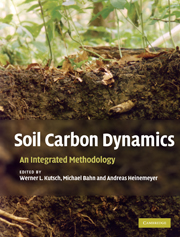Book contents
- Frontmatter
- Contents
- List of Contributors
- Preface
- Editorial Acknowledgements
- 1 Soil carbon relations: an overview
- 2 Field measurements of soil respiration: principles and constraints, potentials and limitations of different methods
- 3 Experimental design: scaling up in time and space, and its statistical considerations
- 4 Determination of soil carbon stocks and changes
- 5 Litter decomposition: concepts, methods and future perspectives
- 6 Characterization of soil organic matter
- 7 Respiration from roots and the mycorrhizosphere
- 8 Separating autotrophic and heterotrophic components of soil respiration: lessons learned from trenching and related root-exclusion experiments
- 9 Measuring soil microbial parameters relevant for soil carbon fluxes
- 10 Trophic interactions and their implications for soil carbon fluxes
- 11 Semi-empirical modelling of the response of soil respiration to environmental factors in laboratory and field conditions
- 12 Modelling soil carbon dynamics
- 13 The role of soils in the Kyoto Protocol
- 14 Synthesis: emerging issues and challenges for an integrated understanding of soil carbon fluxes
- 15 Appendix: Towards a standardized protocol for the measurement of soil CO2 efflux
- Index
- References
5 - Litter decomposition: concepts, methods and future perspectives
Published online by Cambridge University Press: 11 May 2010
- Frontmatter
- Contents
- List of Contributors
- Preface
- Editorial Acknowledgements
- 1 Soil carbon relations: an overview
- 2 Field measurements of soil respiration: principles and constraints, potentials and limitations of different methods
- 3 Experimental design: scaling up in time and space, and its statistical considerations
- 4 Determination of soil carbon stocks and changes
- 5 Litter decomposition: concepts, methods and future perspectives
- 6 Characterization of soil organic matter
- 7 Respiration from roots and the mycorrhizosphere
- 8 Separating autotrophic and heterotrophic components of soil respiration: lessons learned from trenching and related root-exclusion experiments
- 9 Measuring soil microbial parameters relevant for soil carbon fluxes
- 10 Trophic interactions and their implications for soil carbon fluxes
- 11 Semi-empirical modelling of the response of soil respiration to environmental factors in laboratory and field conditions
- 12 Modelling soil carbon dynamics
- 13 The role of soils in the Kyoto Protocol
- 14 Synthesis: emerging issues and challenges for an integrated understanding of soil carbon fluxes
- 15 Appendix: Towards a standardized protocol for the measurement of soil CO2 efflux
- Index
- References
Summary
LITTER DECOMPOSITION CONCEPT
Litter decomposition is defined as the process through which dead organic material is broken down into particles of progressively smaller size, until the structure can no longer be recognized, and organic molecules are mineralized to their prime constituents: H2O, CO2 and mineral components. During the process, recalcitrant organic compounds are formed and dissolved organic carbon may be leached to the mineral soil. It is also universally recognized that there are three main processes through which decomposition occurs: (1) leaching of soluble compounds into the soil, (2) fragmentation of litter into smaller sizes and (3) catabolism by decomposer organisms (i.e. micro-organisms and fauna). Swift et al. (1979), presented the triangle (P–O–Q), representing individual and interacting factors influencing litter decomposition: i.e. P for the physical–chemical environment; O for decomposer organisms and Q for resource quality (Fig. 5.1).
This definition and understanding, so clearly stated, has guided research on litter decomposition for the past decades, which has been devoted mainly to:
quantify rates of litter decay
develop mathematical models that better represent decay dynamics
identify litter quality factors that control decay rates, and eventually the equation defining the relationship
determine dynamics of nutrients and carbon-based compounds during litter decay
identify climatic factors that control decay, and eventually the equation defining the relationship
identify the interdependence between litter quality and climate
evaluate the role of soil organisms.
- Type
- Chapter
- Information
- Soil Carbon DynamicsAn Integrated Methodology, pp. 76 - 90Publisher: Cambridge University PressPrint publication year: 2010
References
- 22
- Cited by

